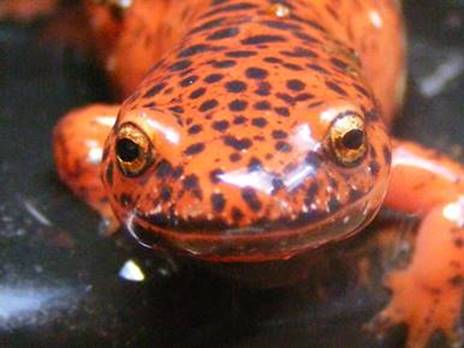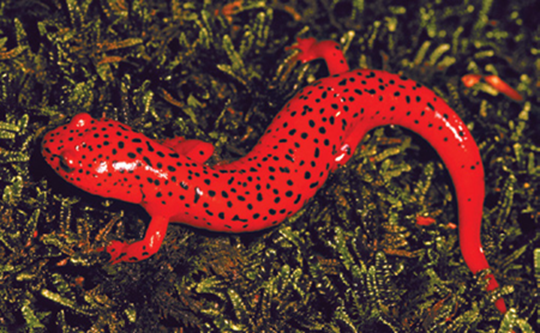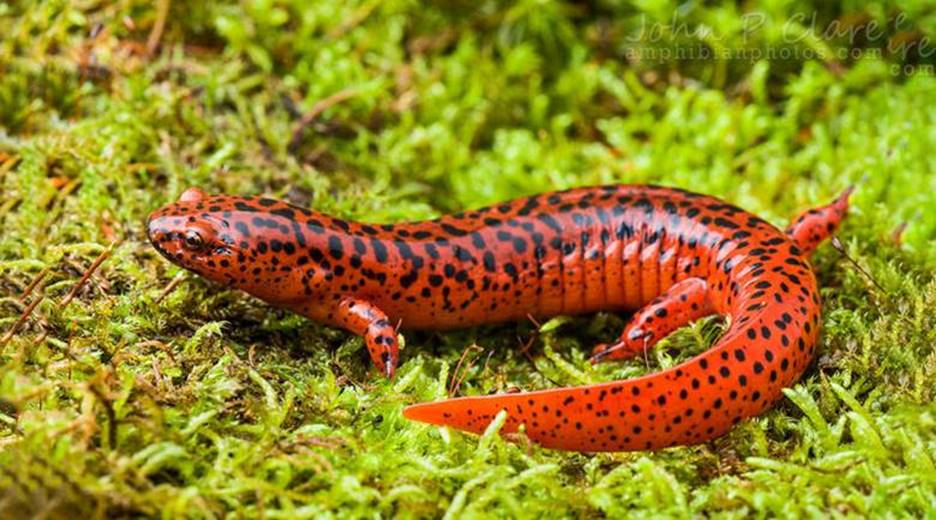This has no digestive organs, and gets no food but from the fire, in which it constantly renews its scaly skin. The salamander, which renews its scaly skin in the fire,—for virtue. — Leonardo da Vinci.
These are large, brightly colored salamanders found along the east coast of the U.S. They are rather stout and about 4-6 inches long. They are very bright reddish orange with many irregularly rounded, black spots and a lighter belly. The species occurs throughout much of the eastern U.S. from northern N.Y. to the Florida panhandle. They are most commonly found around springs, seeps, and small creeks.
Adults will wander far from water into upland areas. Northern reds look similar to the mud salamander (P. montanus) of the southeast U.S. but northern reds have a yellow iris and a longer snout than the mud salamander. They have relatively short tails for their body size and have 16 coastal groves on the side of their body.


Males and females are similarly colored with females being slightly larger. They are plethodontid salamanders and lack lungs, absorbing oxygen through their skin and mouth lining. Thus, staying moist a primary concern. Lungless salamanders are thought to have evolved 100 million years ago in the area of what is now Appalachia. It is surmised that having no lungs is an adaptation to life in flowing water where the buoyancy of lungs is a detriment to staying close to the stream bottom. In well-aerated flowing water, oxygen exchange through the skin is an efficient alternative to having lungs.
Typically, you can find northern reds under rocks, logs, or other cover near seeps and streams, sometimes just under moss cover. During the day they hide under these features but emerge at night in search of invertebrates or small vertebrate prey. They mostly feed on insect larvae and worms but in some areas most of their diet consists of other smaller salamanders. Northern reds have a fast flicking tongue with a sticky pad at the end that they use for capturing prey. Feeding
Breeding occurs between June and September and eggs are laid in early autumn, averaging 70 eggs per clutch. Adults can often be found on rainy nights crossing roads in search of mates. As in other plethodon salamanders, body rubbing courtship is followed by a “straddle walk” where the female closely follows the male while straddling his tail (may last a couple minutes) until the male deposits a sperm cap on the ground and the female picks it up by her cloaca as she passes. The male has a hedonic gland at the tip of the chin that secretes a sexual stimulant as he rubs his mate. Females will lay eggs in headwater streams in hidden nests.
Males sometimes initiate a courtship with another male. This behavior is thought to be “sexual interference” whereby a male attempts to cause another male to release unnecessary spermatophores, thus reducing his ability to pass on his genes.
The young hatch and spend 27-31 months in the stream. At this stage they have gills and will metamorphose into adults in the spring or summer of their third year, depending on water temperature. Adults often live in burrows along streams and seeps and under moist environments such as under logs and rocks.
Pseudes – Greek for false and triton – Greek sea god, which it supposedly resembles; ruber is Latin for red. The species was first described in 1801 by Pierre Andre Latreille from a collection of fellow Frenchman A.M.F. J. Palisot de Beauvois.
Latreille got caught up in the French Revolution and was imprisoned. When the prison doctor was inspecting groups he was surprised to find Latreille examining a beetle that he found on the dungeon floor. Latreille explained that it was a rare species and the impressed doctor sent the beetle to a local 15-year-old naturalist, Jean Baptiste Bory de Saint-Vincent. St-Vincent knew of Latreille’s work and helped secure his release. I don’t remember that scene in Les Miserables, but it apparently pays to know beetle taxonomy!
Northern reds have glands that produce a toxic secretion to ward off predators. When threatened thy will curl their bodies into a C-shape, wrapping their tail and hind limbs around their head. There is some debate as to if this is related to warning postures of other salamanders that have toxic secretions.
Northern reds can be preyed upon by raccoons, woodland birds, striped skunk and some species of shrews and snakes. Other salamanders are known to feed on larval northern red salamanders.
I went to undergraduate college in NJ, my home state, and we had various opportunities to travel around and hunt for critters. Because of glacial history, or lack thereof, the east coast and particularly the southeast is much richer in amphibian diversity than up here in the recently glaciated Pacific Northwest. One weekend out to Stokes State Forest in northern NJ we were carpooling around to different habitats in search of reptiles and amphibians. Our professor had us park on the side of a forest road and led us down a rock path to a wide bench along a stream full of springs and seeps under a canopy of eastern hemlock.

We slowly wandered around, carefully turning over rocks and logs like biological prospectors. I lifted a clump of loose moss off a seepy area and there sat a shiny northern red salamander, about 5 inches long. It was chubby and startling bright red against the green moss, with contrasting deep black spots like some semi-aquatic little leopard. It glistened.
As deems herpetology hunting protocol, you yell out the species name of your discovery and your colleagues gather – “awesome”, “great catch”, “oh – just crazy gorgeous”. After a few minutes of ogling we placed him back on his perch and pulled back his covers of green moss and let him be.
